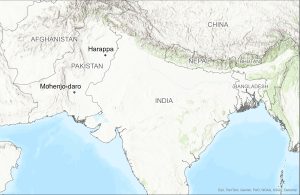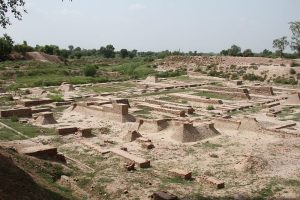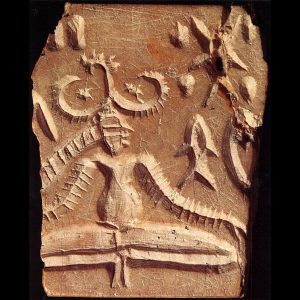5 Geography

Indus Valley Civilization
The ancient Indus Valley Civilization that flourished from about 2500-1500 BCE provides the basis of Indian religious history. Archaeological remains show large cities at Mohenjo-daro and Harappa located on man-made hills near the Indus River. These cities were laid out carefully with a rectangular grid of streets. Homes were made from baked bricks. Bathing areas and latrines allowed waste water to flow away from the city through a system of drains. The physical organization of the city suggests a settled, orderly civilization.

Modern archaeological investigations have uncovered sculptures and carved stone seals in these two sites. The seals are marked with symbols and images of male animals. There is little human representation, with the exception of an ambiguous figure, seated with the soles of his feet touching, and wearing a headdress of horns. Animals sometimes are shown with the figure as if he were a god of animals. In one seal, the man sits with feet together in a yogic posture, suggesting that even this ancient society practiced some form of mental and physical discipline and meditation.

The seals suggest rituals, worship, and myths of divine heroes and animals, but we know very little of this ancient religion since we do not understand the script on the seals. Some scholars speculate that there is a connection between these ancient gods of the Indus Valley civilization and the Hindu gods of Siva and Devi. The archaeological remains of Mohen-jodaro and Harappa suggest an organized, agricultural, advanced and probably peaceful society of a settled people.
Aryan Nomadic Groups
In approximately 1800-1600 BCE, nomadic northern tribes entered the geographical area of the Indus Valley Civilization, having crossed the mountains of Afghanistan. By this time the Indus Valley Civilization was already in decline. The nomadic northern tribes referred to themselves as the Aryans, or the noble ones, sharing a language and culture similar to other tribes that moved westward into Europe. They were pastoralists, moving their animals in search of grazing territory.
The Aryans, in contrast to the Indus Valley peoples, valued warrior skills and their horse-drawn chariots. They fought the local Indus Valley residents, then continued eastward. Their culture was portable: their language, their hymns, and their ritual practices were adapted to life on the move. For example, the fire sacrifice that was so highly valued in Vedic religion was performed on altars constructed for each occasion, then dismantled. The entire process of the ritual was sacred, but was extremely portable since no permanent altars were required for its performance.
